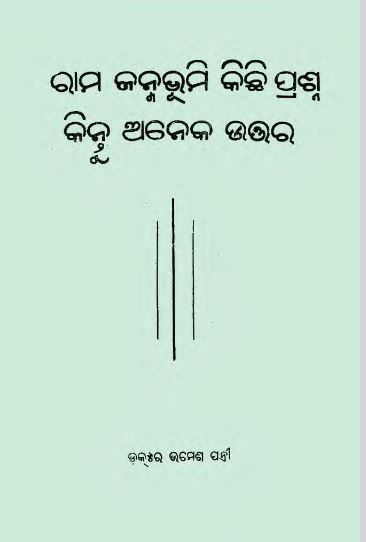Published in 1990, Rama Janmabhumi Kichhi Prasna Kintu Aneka Uttara by Umes Patri is a significant work that delves into the complex and charged topic of the Ram Janmabhoomi site in Ayodhya, a focal point of cultural and religious contention in India. The book addresses the myriad questions surrounding the site where Hindus believe Lord Rama was born, juxtaposing history, faith, and political maneuvering in an era marked by communal tensions.
Drawing on a rich tapestry of sources, Umes Patri meticulously explores the historical claims surrounding Ayodhya and the Babri Mosque, offering a detailed examination of the evidence that supports various narratives. The author investigates the profound emotional and spiritual significance of the Ram Janmabhoomi site for Hindus, illustrating how it is deeply intertwined with religious identity and cultural heritage. Through a rigorous blend of historical analysis and theological discourse, Patri invites readers to reflect on the complexities of belief systems and the impact of socio-political dynamics on religious sites.
One of the strengths of the book lies in its comprehensive approach to various questions that have emerged over the decades regarding the Ayodhya site. Umes Patri does not shy away from addressing the profound controversies that arose from the Babri Mosque demolition in 1992, a pivotal moment that escalated communal violence and brought into sharp focus the clash between history and modern political narratives. The author probes not only into the past but also strives to comprehend the implications of these events on contemporary society, urging readers to consider the legacy of faith and conflict as intertwined rather than separate entities.
Throughout the narrative, Umes Patri underscores the importance of understanding different perspectives associated with the Ram Janmabhoomi debate. He emphasizes that, although historical interpretations can be divisive, common threads of spirituality and human connection remain such that it is crucial to foster dialogue rather than discord. The book becomes a platform for not just Hindu devotion but also a call for mutual respect and understanding among diverse communities.
Moreover, Patri presents a thought-provoking exploration of symbols, rituals, and the broader implications of sacred spaces. He meticulously delineates how the Ayodhya site has served as a reflection of larger societal values and religious aspirations, while simultaneously becoming a crucible for conflict. The juxtaposition between the historical narratives of the Babri Mosque and the aspirations of Hindu worshippers to reclaim their sacred space complicates the dialogue surrounding identity and belonging.
In Rama Janmabhumi Kichhi Prasna Kintu Aneka Uttara, Umes Patri ultimately provides readers with an opportunity to engage with a multifaceted discourse that transcends mere religious sentiment. He encourages readers to approach the subject with empathy and critical thought, bridging the gap between history and religious faith. This book serves as not just a historical account but also a significant commentary on the essence of community, belief, and the quest for understanding in a world fraught with division.
Overall, Umes Patri’s work is pivotal in fostering awareness about the complexities of the Ram Janmabhoomi debate, marking it as an essential read for anyone seeking to understand the intricate layers of Indian religious and cultural identity during a time of considerable turmoil and transformation.
Books Info
| Books name | Rama Janmabhumi Kichhi Prasna Kintu Aneka Uttara |
| Author | Rajakisor Pati |
| No Of pages | 55 |
| Publisher | Utkal Arya Pratinidhi Sabha |
| Publication | 1990 |
| Printed At | Orissa Printing Works |
| Distributor | NA |
Rama Janmabhumi Kichhi Prasna Kintu Aneka Uttara Sample
Rama Janmabhumi Kichhi Prasna Kintu Aneka Uttara Full Pdf Download

